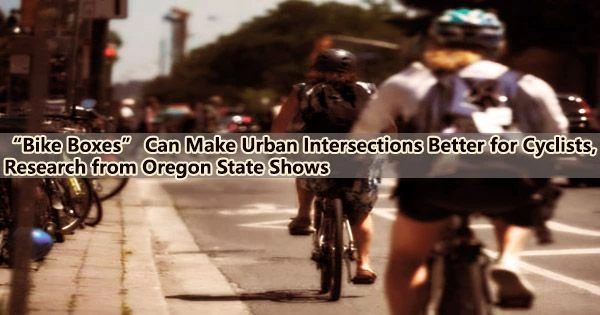According to studies by the Oregon State University College of Engineering, a road configuration known as the “bike box,” a painted-off space for cyclists at the front of an intersection, can help them stay safe at urban, signalized intersections.
The research, which was published in Accident Analysis & Prevention, is significant because, according to the National Highway Traffic Safety Administration, there are an increasing number of cyclists killed in collisions with cars, and almost half of all bicycle-car collisions occur at intersections.
According to the most recent data available, 932 bicyclists died in motor vehicle collisions in the United States in 2020, an 8.9% rise over the 856 fatalities in 2019. Additionally, the National Safety Council, another organization that monitors data on bicycle fatalities, reports a 44% rise in deaths involving bicycle transportation incidents during the previous ten years.
David Hurwitz, a transportation engineering professor at Oregon State, and Logan Scott-Deeter, a civil engineering graduate research assistant, led the study in conjunction with Brendan Russo of Northern Arizona University.
The experiment tested the potential for three types of intersection treatments a mixing zone, bicycle signals, and the bike box to increase safety by simulating traffic situations while pedaling.
In a mixing zone, the bike lane disappears just before a junction and is replaced with other lane markers, such as “sharrows,” which let drivers know that cyclists will be sharing the road with them as they make a right turn.
As the name implies, a bicycle signal is a traffic light designed specifically for bicycles; when it goes green, the rider is permitted to cross the intersection.
Time-space measurements showed that the mixing zone treatment correlated with the most unpredictable riding behaviors. With a bicycle signal, analysis of the participants’ eye movements revealed a lower rate of detecting a potential conflict vehicle. The bike box proved the most effective treatment for encouraging safe riding habits while also providing enhanced safety for bicyclists at signalized intersections.
Professor David Hurwitz
In order to provide bicyclists in the bike lane a head start through the crossroads and make them more visible to drivers, the bike box treatment involves boxing off the front of the intersection from cars using paint.
Hurwitz, Scott-Deeter, Russo and Sirisha Kothuri of Portland State University put 40 research subjects through multiple scenarios in the simulator for each intersection treatment the riders pedaled a stationary bike in front of a large screen displaying the roadway, scenery, vehicles, etc.
The riders’ tracks were traced, their eye movements were observed, their stress levels were recorded, and a survey was given to each subject to gauge how well each design performed for each rider.
The conclusion: According to the researchers, the bike box was the most adaptable solution they looked at since it offered a compromise between greater safety and the need for the rider to recognize potential risk and be prepared to act appropriately.
“Time-space measurements showed that the mixing zone treatment correlated with the most unpredictable riding behaviors,” Hurwitz said. “With a bicycle signal, analysis of the participants’ eye movements revealed a lower rate of detecting a potential conflict vehicle. The bike box proved the most effective treatment for encouraging safe riding habits while also providing enhanced safety for bicyclists at signalized intersections.”
The mixing zone treatment “created the most discomfort” among the riders, the paper notes, but also made them the most careful.
“The mixing zone has potential as a treatment if we are limited by available right of way for other design alternatives,” Scott-Deeter said. “Positioning data indicate cyclists are willing to merge with the traffic, but the sporadic and unpredictable riding habits associated with a mixing zone may expose bicyclists to higher risk.”
Riders when using bicycle signals experienced the highest degrees of comfort, but they tended to be less cautious since they believed the signs would protect them. They also made less eye movements to make sure they weren’t going into danger.
“That might increase the risk of crashing with errant drivers,” Hurwitz said. “The eye-tracking data clearly showed reduced vigilance in searching for potential conflicts at the intersections. Thus we’d recommend installing bicycle signals only when there is a clear need for them.”
The Oregon Department of Transportation supported this study, based on research for ODOT’s Impacts of Intersection Treatments and Traffic Characteristics on Bicyclist Safety report.
















